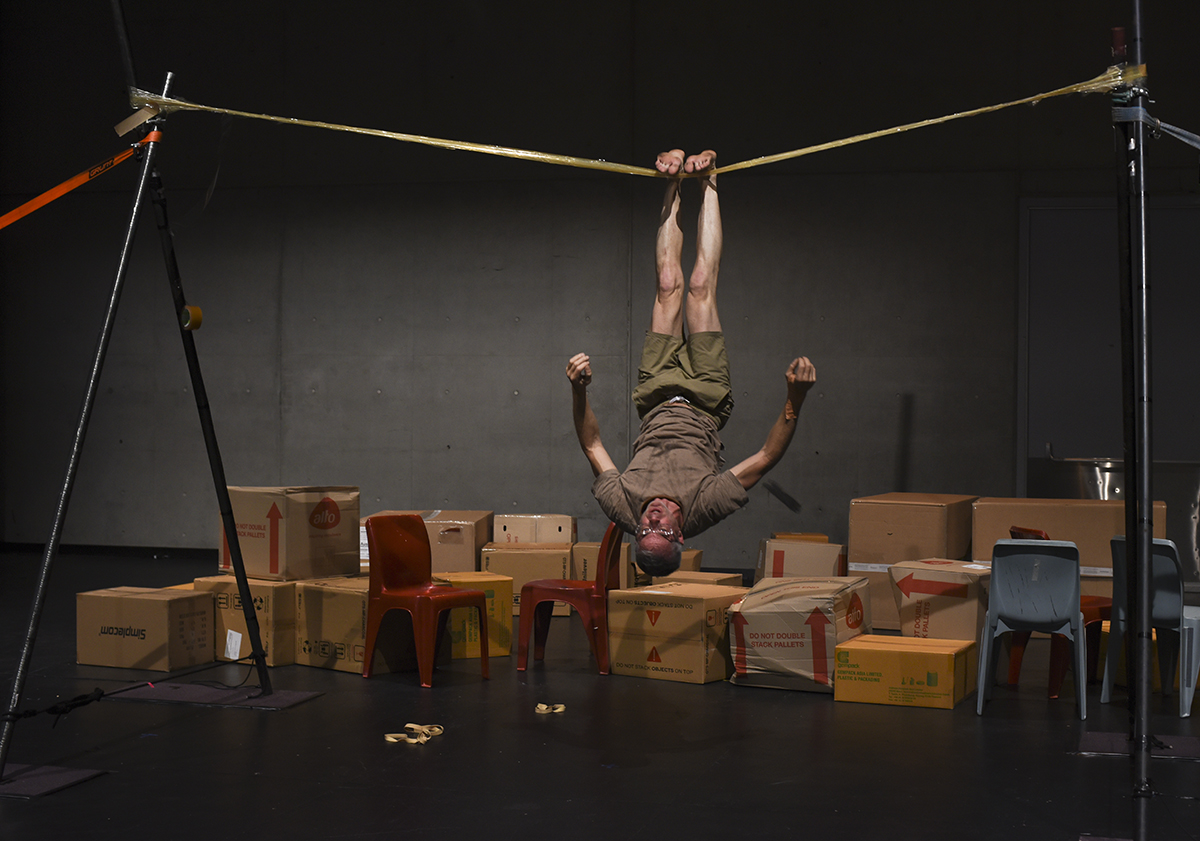
Liveworks 2018: Art testing
Of the eight shows I saw, the greater part of this year’s Liveworks Festival of Experimental Art, I was most taken with two that most palpably extended form and response: Branch Nebula’s High Performance Packing Tape and Rianto’s Medium. I also greatly appreciated works by John A Douglas, Appelspiel and Asuna that took me to unexpected places.
Shortage of time, however, did not permit me to respond at length to the following works. I admired Angela Goh’s cool, witty, allusion packed Uncanny Valley Girl (see reviews in Running Dog, Runway Conversations and Art and Australia). I was bemused by Nicola Gunn’s sardonically quizzical Working with Children if wondering why, on the night I saw it, it didn’t commence with the artist sliding across stage on water as reportedly she did in the Melbourne season (it happened towards the end here). I suspect this undid the thematic and physical tension provided by a slippery surface undercutting the bland, repetitive movement of the work’s first part (see Jana Perkovic’s appreciative review for The Guardian). Tawainese choreographer Su Wen-Chi’s Infinity Minus One was meticulously performed by pairs of Indonesian musicians and dancers, the latter performing precise worshipful supplication and obeisance and then warrior-like aggression towards each other in a universe perhaps something other than Buddhist, its nature characterised by laser beams which never quite meaningfully intersected with the performance in this art-science exercise. All of these works tested me in ways that experimental art should, making for yet another fine Liveworks.
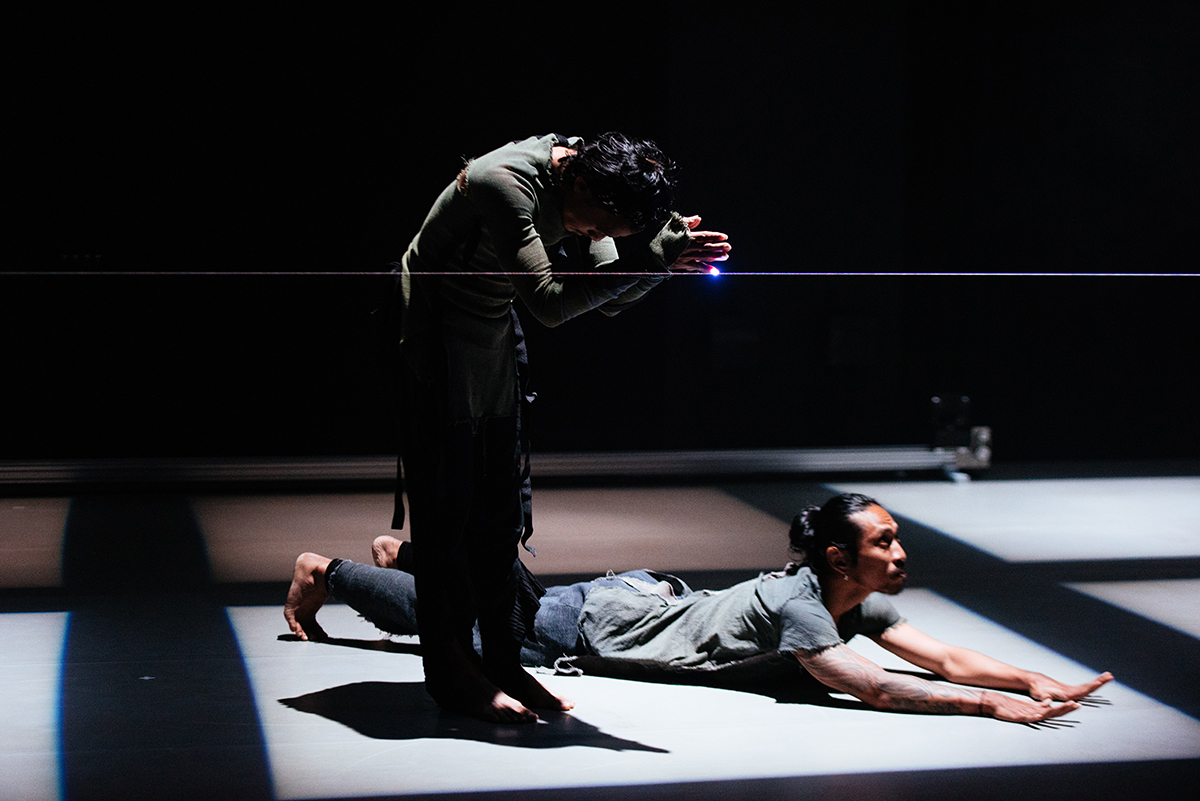
Infinity Minus One, Su Wen-Chi, Liveworks, photo Etang Chen
Branch Nebula, High Performance Packing Tape
In Sydney company Branch Nebula’s High Performance Packing Tape a bespectacled man (Lee Wilson or Lee Wilson as worker) in shorts and t-shirt shifts and stacks empty boxes. He carries an incredibly tall, tilting pile from one space to another. Collapse seems inevitable. He’s indifferent. He neatly piles five or so layers of empty boxes and attempts to climb the whole, twice crashing to the floor — not from a great height, but dangerous enough. He moves on, rigging a tightrope between two poles, the ‘rope’ manufactured live (more work) from large rolls of clear packing tape screechingly and rapidly unfurled between the poles, over and over and, amplified, generating a tense musicality, reinforcing the suspense as the worker executes this task atop a row of barely stable plastic chairs. A mass of noisily inflated balls provides a substitute safety net beneath the taut tape and the walk is embarked on with spectacular results and escalating risk as a box cutter comes into play. Work has thus mutated into circus and will ultimately evoke performance art at play with bondage: not done with the packing tape, the worker, now naked and suspended, cocoons himself in it into a ball of flesh. Done, he one-handedly hoists himself high on a length of woven tape. The box cutter blade slashes (men in the audience wince at the proximity to the scrotum). Incredible, unexpected release. You had to be there.
But it’s not all hard work. In an intriguing earlier scene the worker totally armours himself with bubble wrap, tops it with a milkcrate helmet and wreaks havoc on the boxes with his tape-made whip. Curiously, it’s the one scene in which health and safety are granted palpable priority and playfulness is allowed the worker as action hero defeating the evil that is cardboard (metaphorically all that is dangerous in the workplace). Otherwise he utterly subjugates himself to and tests his capacity to dominate the materials (there are many more than tape and cardboard in this production) and working conditions to which humans have tortuously bound themselves.
For a company committed to explorations of the nature of work and of play as art, High Performance Packing Tape represents a superb synthesis of these preoccupations and the apotheosis to date of Branch Nebula’s creativity. Lee Wilson’s worker is indefatigably industrious, skilled, inventive and risk-taking, facially expressionless, never a clown in this serious circus of the working life. Mirabelle Wouters’ design conjures monumentality out of boxes, air-pumps and exercise balls as does Phil Downing’s amplification and manipulation of the sounds found in Wilson’s labours.

Rianto, Medium, photo Wannes Cré
Rianto, Medium
Well into his performance of Medium, Rianto, suddenly directly in front of us, sweating, for the most part naked, arches forwards, chest and groin pushing out, head back, arms wide, hands sweeping, as if urgently in search of breasts and womb that cannot be found. The act is impassioned but seemingly unconscious. Rianto is in a trance state, self-induced in the performance’s commencement and from which spring the key motions of Lengger, a Javanese dance in which men perform as women. It’s a folk dance, but one richly and exactingly imprinted with the steps and highly articulated gestures of courtly dance; within it Rianto becomes a princess but also her long-awaited warrior prince lover. None of this is literalised; rather it is embedded in a contemporary dance performance.
For those lucky enough to have seem the Indonesian artist’s performance lecture in 2016’s Liveworks, in which, at first fully costumed, Rianto illustrated each aspect of Lengger choreography, much of Medium’s dance was thrillingly recognisable. In that performance, removing masks and layer after layer of deep-folded costuming, he also revealed the inherent ambiguity of his private relationship with a female self, but not with the seismic intensity of this twice enacted moment of fraught possession in Medium. Medium also took us deeper into Lengger’s transformative potential as a shaman-like Rianto becomes a bird, finely mimed and vocally articulated. Further ambiguity ensues when Rianto’s superb collaborating musician, Cahwati, casually takes to the stage as princess to his prince, passing her string bow across his body — either erotic stroking or defiant distancing.
Rianto’s meticulous, highly engaged performance, its sustaining and expanding of tradition and that deeply strange feeling of entering a less than conscious world in which the dichotomies of gender dissolve, re-form and dissolve again, these make a for a great work. For a more detailed account of Medium and its context, see Ben Brooker’s review for Witness.
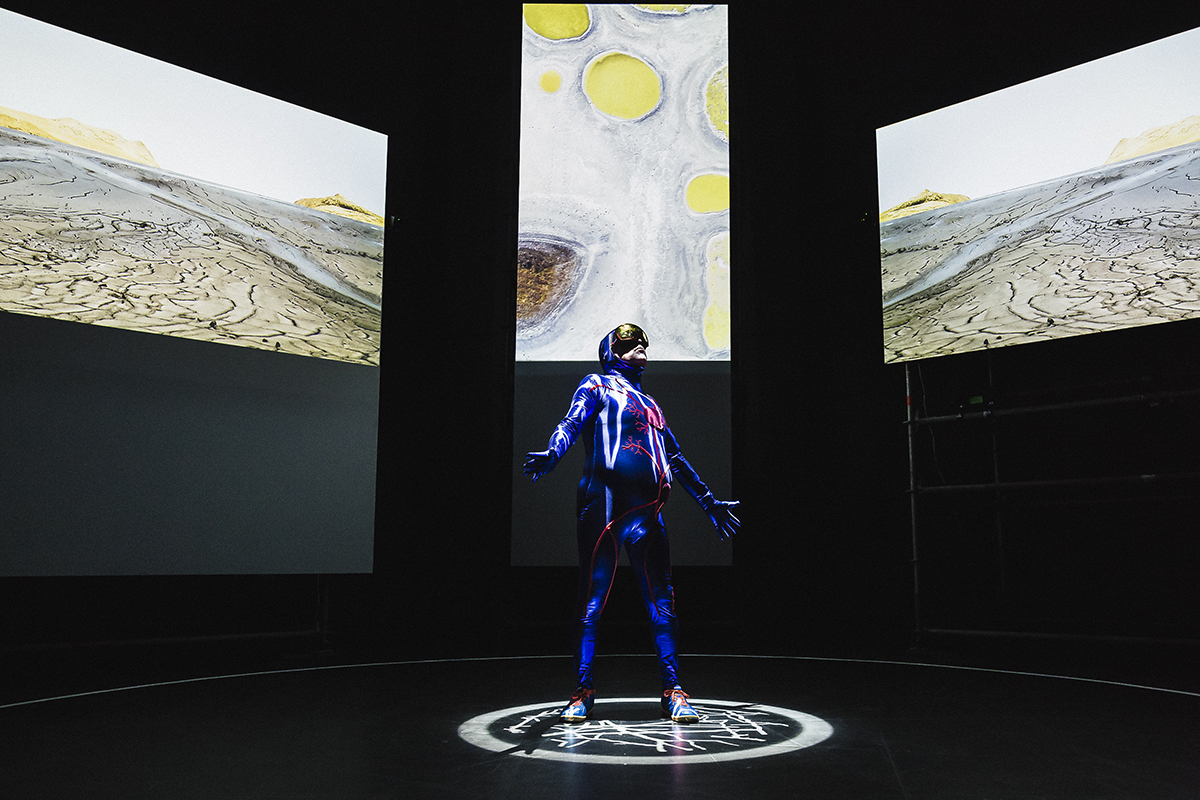
John A Douglas, Circles of Fire: The Amphitheatre, Liveworks, photo Gotaro Uematsu
John A Douglas, Circles of Fire: The Amphitheatre
John A Douglas’ Circles of Fire represents, in its collective modular forms (installation, durational performance art, VR and performance), a provisional triumph over disability in a body bearing a transplanted kidney and requiring constant medication, exercise and psychological assimilation. In the durational Cannulation Performance we witness a totally white-bandaged Douglas administered an intravenous drip by nurse and performance artist Stella Topaz. Douglas’ movement is limited to a slow downward tilt of the head while his free arm travels almost imperceptibly down across his torso, evoking the body at its most damaged and vulnerable, but cared for with a simple touch from his nurse. What plays out on the three screens suggests that this almost stilled being has a remarkable interior life — vast deserts, volcanoes, salt lakes, lush forests, ancient ruins variously evoking phases of agony, comfort and transcendence. These images of sites that seemed for the artist “to resonate as places of solace and healing,” were taken from around the world by the artist himself.
The 30-minute Amphitheatre Performance is a complex creation structured around the stages of Douglas’ illness, its viral beginnings (“Nausea”), the nearness of death (“L’Eclisse”) and the battle to live, venturing on to “Normalising the Body” and resolving in a climactic “Victory Lap.” On the trio of screens the landscape images recur, Douglas occasionally appearing in the distance or racked with nausea between the columns of a Roman ruin. New images appear: threatening eclipses, a contrasting, otherworldly floating iridescent ball. Onstage, Douglas struggles to merge with the projections, leaning with slow turns, arms raised, into the lower ones and scaling the scaffolding of the high central screen. But in the performance’s final stages, newly attired in a dazzling blue Lycra bodysuit on which is vividly embroidered in red the replacement kidney and connecting artery, Douglas appears as a triumphant super hero, astride a wide circle, at first a black hole, but then patterned and around which he runs with agility and a sense of security. He remains masked and wordless, but the expressivity of body, imagery and soundtrack suggest a newly found well-being and oneness with the body (even one inhabited by alien DNA) from which he had been so brutally distanced. The power of Circles of Fire: The Amphitheatre resides in the dynamic interplay between a singular, suffering body and the cosmological totality of images resonant with the artist’s pain, expressing it but also offering consolation and a place in the universe. Douglas’ extensive creative team, led by producer Bec Dean, has done the artist proud in assisting him to realise a magically enlightening phantasmagoria. (Read an interview with John A Douglas.)
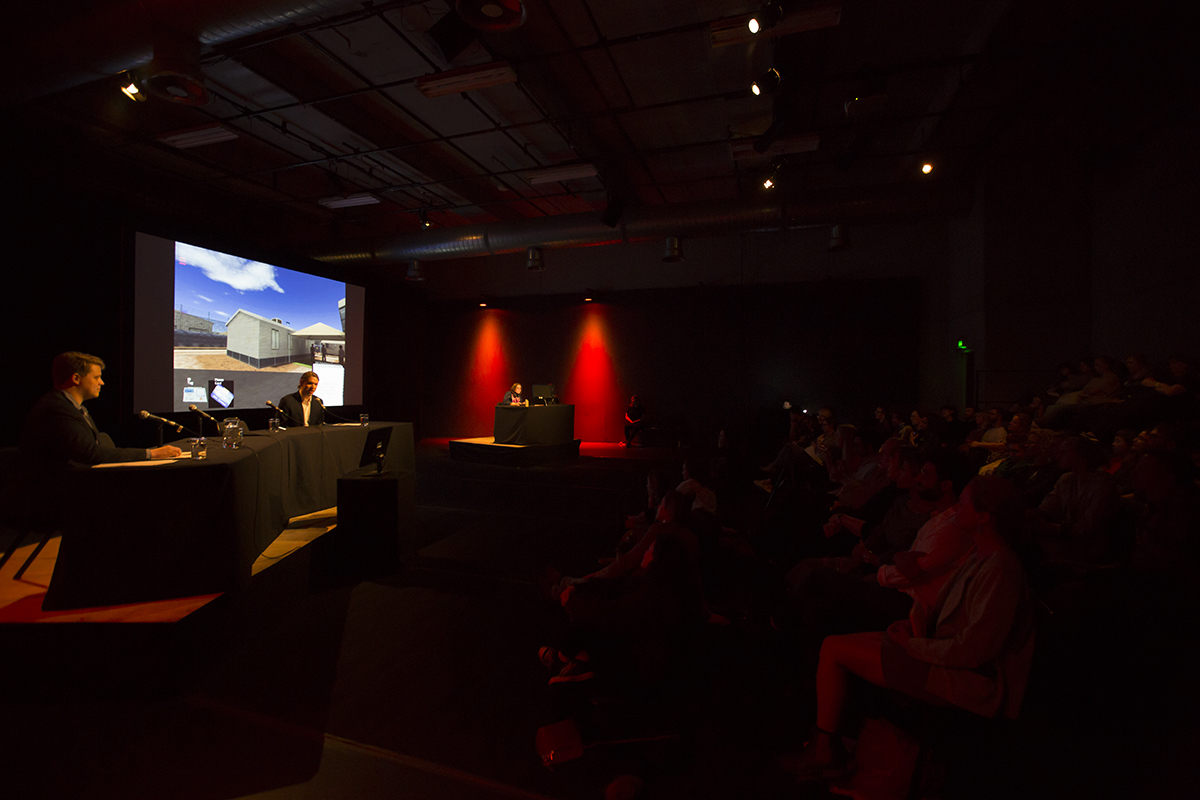
Return to Escape from Woomera, Applespiel, Liveworks, photo Alex Davies
Appelspiel, Escape from Womerah
In Escape from Woomera, Sydney performance ensemble Appelspiel engagingly fuse computer gameplay with a talk show format over several hours. As individual players attempt, one at a time, to assist a video game refugee to escape the infamous Woomera detention centre (projected onto a large screen), amiable Appelspiel members host a discussion with guests: on the night I attend they are Australian barrister and refugee advocate Julian Burnside and writer Creatrix Tiara, who, among other things, has made games about immigration. The conversation is rich in anecdote and alarming information, frequently focusing on Australia’s failure of empathy and the illegality of our treatment of legitimate asylum seekers as “illegals.”
Our attention switches between panel and screen; alert audience members are quick to point out progress and on this night there was near success. Appelspiel fill us in on the 2003 video game, Escape from Woomera (makers Mark Angeli, Julian Oliver, Ian Malcolm, Stephen Honegger, Kate Wild and Morgan Simpson), much more sophisticated than I’d imagined, and the then Coalition Government’s objections to its Australia Council funding (the council disowned the work) and alleged potential to trigger an actual escape. As players finish their games, Appelspiel members interview them about the experience. The player who nearly succeeded admitted that he had to put aside feelings for the characters he was engaging with in the detention centre in order to play the game as hard as he could.
Although it could be argued that Return to Escape from Woomera is one for the converted, it’s vital that the assumedly converted become more deeply informed, see the issue from a wider range of perspectives and, for younger audiences, be mindful how little has changed since 2003. Appelspiel offered us that opportunity, especially for those prepared to stay for an hour or two or three of dialogue, including with the audience (with reflections on this night from Yana Taylor, one of the creators of Version 1.0’s A Certain Maritime Incident) and contemplation as an alternative to ingesting a few daily news bites.
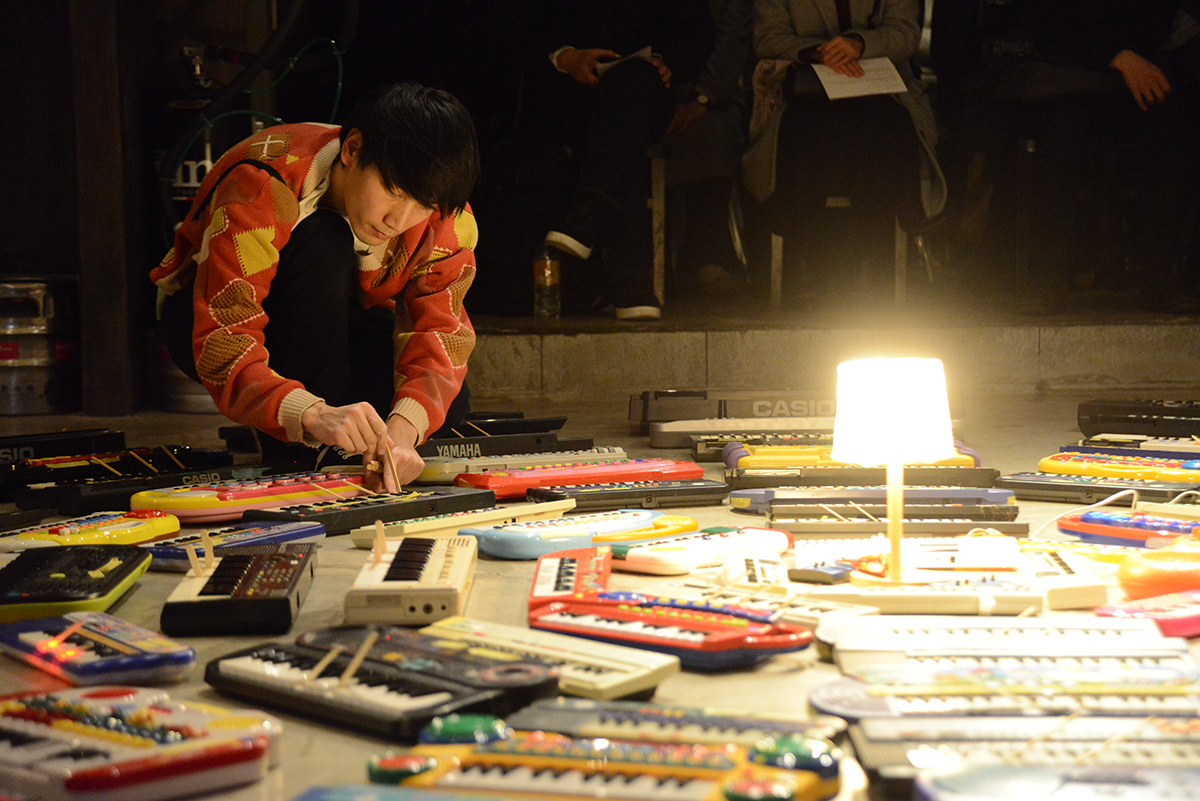
Asuna, 100 Keyboards, photo Ritsuko Sakata
Asuna, 100 Keyboards
Japanese sound artist and experimental musician Asuna, like Lee Wilson in High Performance Packing Tape, is another man tirelessly at work, in this case revealing the collective potential of his battery-operated keyboards, mostly toys and other portables. The instruments are packed into a large circle through which the artist delicately moves, turning on one at a time, setting controls, locking keys into place with wooden ice cream sticks, returning obsessively to particular machines, leaning in and listening attentively, making adjustments, moving on. The first sounds are predictably thin, reedy, buzzy, but as more machines are activated the sound grows denser seemingly filling with incidental chords and harmonies. According to Asuna, “Multiple sound waves on the same frequency are disseminated in multiple directions, creating a complex distribution of acoustic pressure” (program note). Consequently he encourages us to wander the space to register “subtle variations of sound interference and resonance.” The shifting coalescence of humble sounds assumes an immersive, richly textured orchestral presence exuding, unlikely as it would seem, deeper notes and hinted rhythms. In the final phase, Asuna slowly reduces volumes, unpicks sticks and switches off his devices down to the very last, but unlike the beginning where the sounds seemed innocently toy-like, notes now sound substantial and complex resonances linger like a beatiful haunting. A weary Asuna tosses us ice cream sticks as mementoes.
–
Performance Space, Liveworks Festival of Experimental Art, Carriageworks, Sydney, 18-28 Oct
Top image credit: Lee Wilson, High Performance Packing Tape, Branch Nebula, Liveworks, photo Heidrun Löhr






